Rock Material Recycling in Tunnel Engineering
Abstract
1. Introduction
2. Recycling Prediction at the Brenner Base Tunnel
3. Geological Overview of the Brenner Base Tunnel
4. Rock Characteristics of Quartz Phyllites and Bündner Schists
4.1. Rock Quality of the Source Rocks
4.2. Tunnel Driving Method and Its Impact on Rock Material Quality
4.2.1. Excavation by Blasting
- Breaking of rock: drilling, loading with dynamite, blasting and ventilation
- Mucking: material transport via dump trucks, on rails or by conveyor belts
- Support: rock-face sealing with shotcrete, using anchors, tunnel arches, etc.
4.2.2. Excavation via Tunnel Boring Machine (TBM)
4.3. Geometric Characteristics of the Excavated Rock Material
4.4. Concrete Mix Design Experimentation
5. Excavation Material Processing at the Brenner Base Tunnel
5.1. General
5.2. Plant Concept
5.3. Characteristics of Produced Aggregate
5.4. Current Stage Regarding Excavation Material Processing
6. Conclusions
Author Contributions
Funding
Acknowledgments
Conflicts of Interest
References
- ITA Report No. 21: Handling, Treatment and Disposal of Tunnel Spoil Materials; Working Groups 14 and 15–Underground Construction and the Environment and Mechanized Tunneling; International Tunneling and Underground Space Association ITA: Lausanne, Switzerland, 2019.
- Ritter, S.; Einstein, H.; Galler, R. Planning the handling of tunnel excavation material–A process of decision making under uncertainty. Tunn. Undergr. Space Technol. 2013, 33, 193–201. [Google Scholar] [CrossRef]
- Lieb, R.H. Materials management at the Gotthard Base Tunnel—Experience from 15 years of construction. Geomech. Tunnelbau 2009, 2, 619–626. [Google Scholar] [CrossRef]
- BLS AlpTransit Lötschberg: Final Report Logistics in Excavation and Material Management (Schlussbericht Logistik Ausbruch- und Materialbewirtschaftung); IG-LBT Ingenieurgemeinschaft Lötschberg-Basistunnel: Niedergesteln, Switzerland, 2008. (In German)
- Thalmann, C. Ergänzende Prüfungen zu den bestehenden Beton-Normen für gebrochene Zuschlagstoffe–Erfahrungen beim AlpTransit Gotthard. Z. Schweiz. Ing. Archit. 1994, 24, 532–536. (In German) [Google Scholar]
- Resch, D.; Lassnig, K.; Galler, R.; Ebner, F. Tunnel excavation material—High value raw material. Geomech. Tunnelbau 2009, 2, 612–618. [Google Scholar] [CrossRef]
- Bellopede, R.; Brusco, F.; Oreste, P.; Pepino, M. Main Aspects of Tunnel Muck Recycling. Am. J. Environ. Sci. 2011, 7, 338–347. [Google Scholar] [CrossRef]
- Bellopede, R.; Marini, P. Aggregates from tunnel muck treatments. Properties and uses. Physicochem. Probl. Miner. Process. 2011, 47, 259–266. [Google Scholar]
- Thalmann, C. Characterisation and Possibilities of the Utilisation of Excavated Rock Material by Tunneling Boring Machines as Concrete and Shotcrete Aggregates. Ph.D. Thesis, Swiss Federal Institute of Technology Zurich (ETH), Zürich, Switzerland, 1996. (In German). [Google Scholar]
- Gertsch, L.; Fjeld, A.; Nilsen, B.; Gertsch, R. Use of TBM muck as construction material. Tunn. Undergr. Space Technol. 2000, 15, 379–402. [Google Scholar] [CrossRef]
- Burger, D.; Kohlböck, B.; Schoitsch, C. Geotechnics and mass balance of the earthworks for the second tube of the Tauern Tunnel. Geomech. Tunn. 2010, 3, 4. [Google Scholar] [CrossRef]
- Riviera, P.P.; Bellopede, R.; Marini, P.; Bassani, M. Performance-based re-use of tunnel muck as granular material for subgrade and sub-base formation in road construction. Tunn. Undergr. Space Technol. 2014, 40, 160–173. [Google Scholar] [CrossRef]
- Mlinar, C.; Sempelmann, F.; Koch, G.; Steiner, M.; Kubin, F. Tunnel spoil as a source of raw materials for an autobahn—Sustainable reuse of resources through the example of the S 10/Tunnelausbruch als Rohstoffquelle für eine Autobahn—Nachhaltige Ressourcenverwertung am Beispiel der S 10. Geomech. Tunnelbau 2014, 7, 428–436. [Google Scholar] [CrossRef]
- Raderbauer, B.; Wyss, A. Tunnel excavation material as resource for underground power plants and concrete dam constructions/Tunnelausbruch als Rohstoff für den unterirdischen Kraftwerks- sowie Staumauerbau im Hochgebirge. Geomech. Tunnelbau 2014, 7, 451–460. [Google Scholar] [CrossRef]
- Oggeri, C.; Fenoglio, T.M.; Vinai, R. Tunnel spoil classification and applicability of lime addition in weak formations for muck reuse. Tunn. Undergr. Space Technol. 2014, 44, 97–107. [Google Scholar] [CrossRef]
- Erben, H.; Galler, R. Tunnel spoil—New technologies on the way from waste to raw material/Tunnelausbruch—Neue Technologien für den Weg vom Abfall zum Rohstoff. Geomech. Tunnelbau 2014, 7, 402–410. [Google Scholar] [CrossRef]
- Reichel, P. Tunnel spoil: Tipping or the end of the definition as waste/Tunnelausbruch: Deponierung oder Abfallende. Geomech. Tunnelbau 2014, 7, 419–427. [Google Scholar] [CrossRef]
- Danzer, M. Waste law framework for the recovery of material excavated from tunnels/Abfallrechtliche Rahmenbedingungen für die Verwertung von Tunnelausbruchmaterial. Geomech. Tunnelbau 2014, 7, 411–418. [Google Scholar] [CrossRef]
- Posch, H.; Murr, R.; Huber, H.; Kager, M.; Kolb, E. Tunnel excavation—The conflict between waste and recycling through the example of the Koralm Tunnel, contract KAT2/Tunnelausbruch—Das Spannungsfeld zwischen Abfall und Verwertung am Beispiel Koralmtunnel, Baulos KAT2. Geomech. Tunnelbau 2014, 7, 437–450. [Google Scholar] [CrossRef]
- EU Funded Research Project “DRAGON”. Available online: https://europa.eu/investeu/projects/dragon-%E2%80%93-innovative-approach-tunnelling_en (accessed on 7 April 2020).
- Bergmeister, K.; Cordes, T.; Murr, R. Novel semiprobabilistic tunnel lining design approach with improved concrete mixture. Tunnels and Underground Cities: Engineering and Innovation meet Archaeology, Architecture and Art. In Proceedings of the WTC 2019 ITA-AITES World Tunnel Congress, Naples, Italy, 3–9 May 2019; pp. 1714–1723. [Google Scholar]
- Cordes, T.; Dummer, A.; Neuner, M.; Hofstetter, G.; Bergmeister, K. The load-bearing capacity of primary linings with consideration of time-dependence at the Brenner Base Tunnel. In Proceedings of the ITA-AITES World Tunnel Congress 2019, Naples, Italy, 3–9 May 2019. [Google Scholar]
- Dengg, F.; Zeman, O.; Voit, K.; Bergmeister, K. Fastening application in concrete using recycled tunnel excavation material. Struct. Concr. 2017, 19, 374–386. [Google Scholar] [CrossRef]
- Bergmeister, K.; Kogler, H.; Murr, R.; Cordes, T.; Arnold, R. Brenner Basistunnel–Innovationen zur Aufbereitung des Tunnelausbruchmaterials und Optimierung der Betonzusammensetzung. Das größte Tunnelbauprojekt Europas. Zement+Beton 2016, 1, 48–57. [Google Scholar]
- Voit, K.; Zeman, O.; Murr, R.; Bergmeister, K.; Arnold, R. Aufbereitung und Wiederverwertung von Tunnelausbruchmaterial beim Brenner Basistunnel. Beton Stahlbetonbau 2015, 110, 832–844. [Google Scholar] [CrossRef]
- BBT SE: UVE—Ausbruchmaterial und Eigenschaften. Technische Projektaufbereitung. Fachbereich Geologie, Geotechnik, Hydrogeologie. Haupttunnel; Technischer Bericht: Vienna, Austria, 2008.
- BBT SE: Ausbruchmaterialbewirtschaftungskonzept. Eisenbahnrecht, Technische Projektaufbereitung. Fachbereich Bauphasen; KL-D0118-BR-04340-10; Technischer Bericht: Vienna, Austria, 2008.
- Bergmeister, K. Brenner Basistunnel—Lebensräume und Verkehrswege; 1. Auflage; Tappeiner: Innsbruck, Austria, 2008. [Google Scholar]
- Brandner, R.; Reiter, F.; Töchterle, A. Überblick zu den Ergebnissen der geologischen Vorerkundung für den Brenner-Basistunnel. Geo. Alp. 2008, 5, 165–174. [Google Scholar]
- Voit, K. Application and Optimization of Tunnel Excavation Material of the Brenner Base Tunnel. Ph.D. Thesis, University of Natural Resources and Life Sciences, Vienna, Vienna, Austria, 2013. (In German). [Google Scholar]
- Voit, K.; Zimmermann, T. Characteristics of selected concrete with tunnel excavation material. Constr. Build. Mater. 2015, 101, 217–226. [Google Scholar] [CrossRef]
- Maidl, B.; Jodl, H.G.; Schmid, L.R.; Petri, P. Tunnelbau im Sprengvortrieb; Glückauf: Berlin, German, 1997. [Google Scholar]
- An, H.; Liu, H.; Han, H.; Zheng, X.; Wang, X. Hybrid finite-discrete element modelling of dynamic fracture and resultant fragment casting and muck-piling by rock blast. Comput. Geotech. 2017, 81, 322–345. [Google Scholar] [CrossRef]
- Yang, P.; Lei, Q.; Xiang, J.; Latham, J.-P.; Pain, C. Numerical simulation of blasting in confined fractured rocks using an immersed-body fluid-solid interaction model. Tunn. Undergr. Space Technol. 2020, 98, 103352. [Google Scholar] [CrossRef]
- Liu, R.; Zhu, Z.; Li, Y.; Liu, B.; Wan, D.; Li, M. Study of rock dynamic fracture toughness and crack propagation parameters of four brittle materials under blasting. Eng. Fract. Mech. 2020, 225, 106460. [Google Scholar] [CrossRef]
- Girmscheid, G. Baubetrieb und Bauverfahren im Tunnelbau; Ernst & Sohn Verlag: Berlin, Germany, 2008. [Google Scholar]
- Li, G.; Wang, W.; Jing, Z.; Zuo, L.; Wang, F.; Wei, Z. Mechanism and numerical analysis of cutting rock and soil by TBM cutting tools. Tunn. Undergr. Space Technol. 2018, 81, 428–437. [Google Scholar] [CrossRef]
- Yin, L.; Miao, C.; He, G.; Dai, F.; Gong, Q. Study on the influence of joint spacing on rock fragmentation under TBM cutter by linear cutting test. Tunn. Undergr. Space Technol. 2016, 57, 137–144. [Google Scholar] [CrossRef]
- Voit, K. Recycling of Tunnel Spoil. Ph.D. Thesis, University of Natural Resources and Life Sciences, Vienna, Vienna, Austria, 2016. (In German). [Google Scholar]
- Murr, R.; Cordes, T.; Hofmann, M.; Bergmeister, K. Autarkic aggregate supply with recycled tunnel spoil at the Brenner Base Tunnel. Tunnels and Underground Cities: Engineering and Innovation meet Archaeology, Architecture and Art. In Proceedings of the WTC 2019 ITA-AITES World Tunnel Congress, Naples, Italy, 3–9 May 2019; pp. 495–504. [Google Scholar]
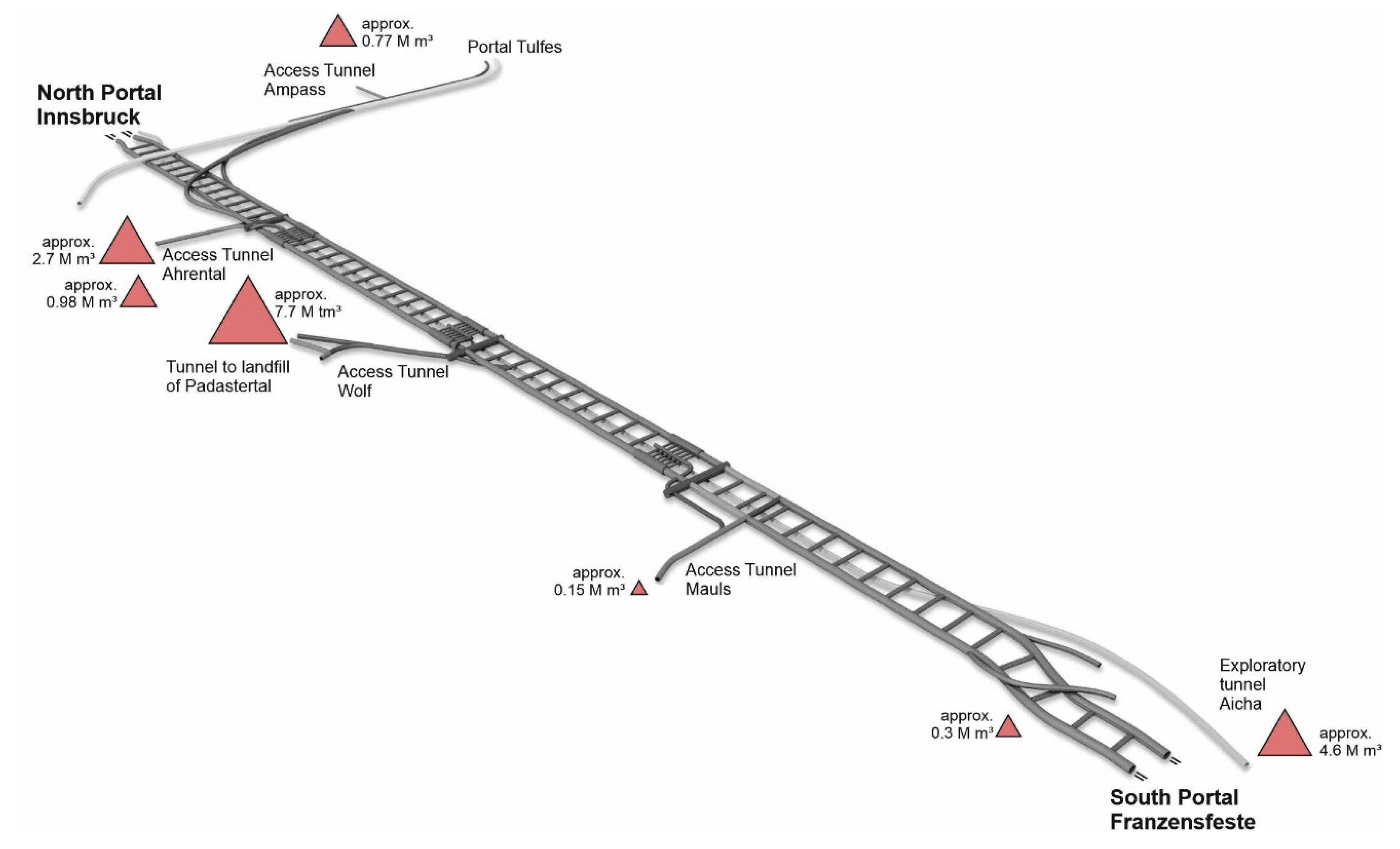



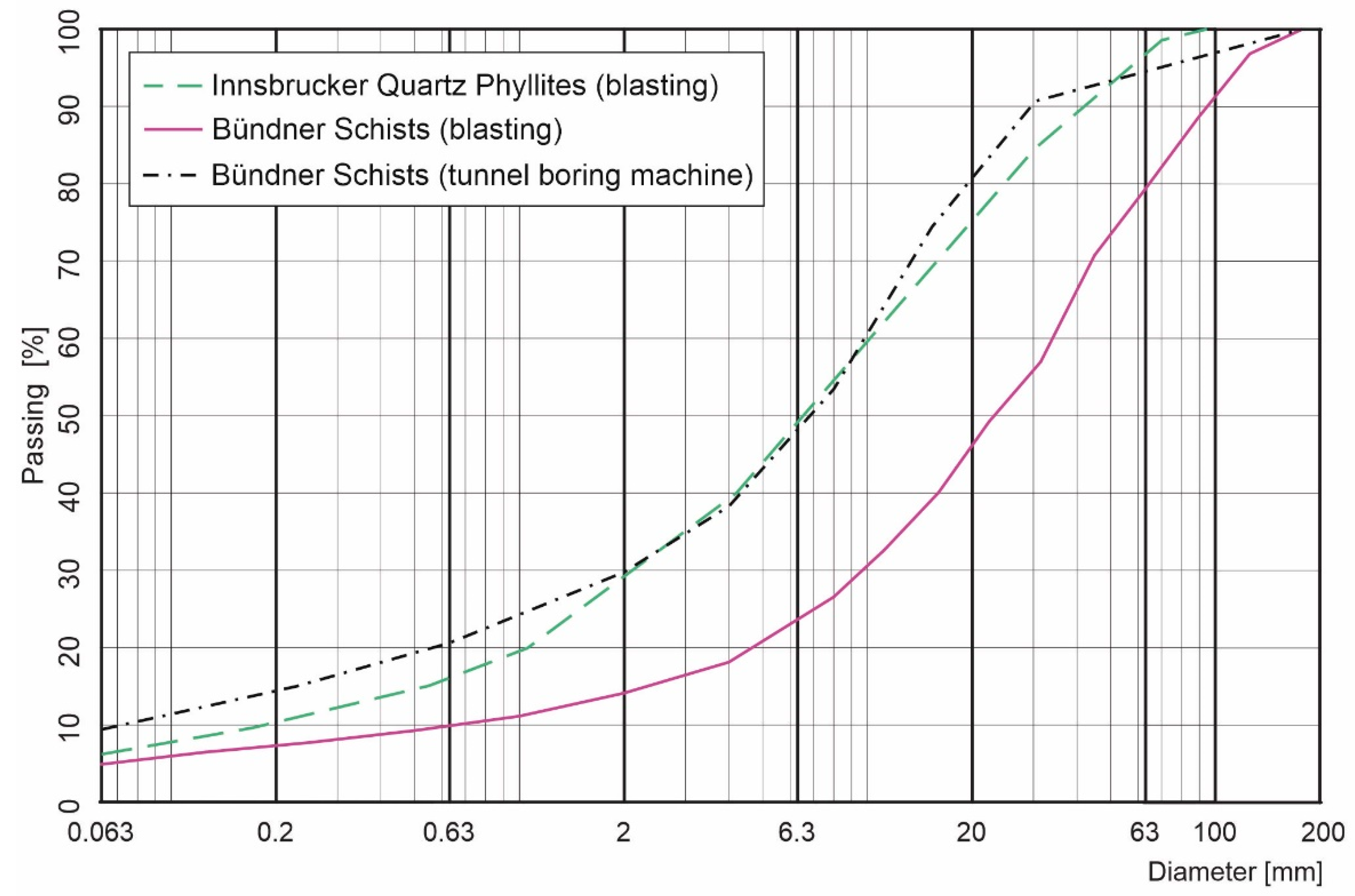
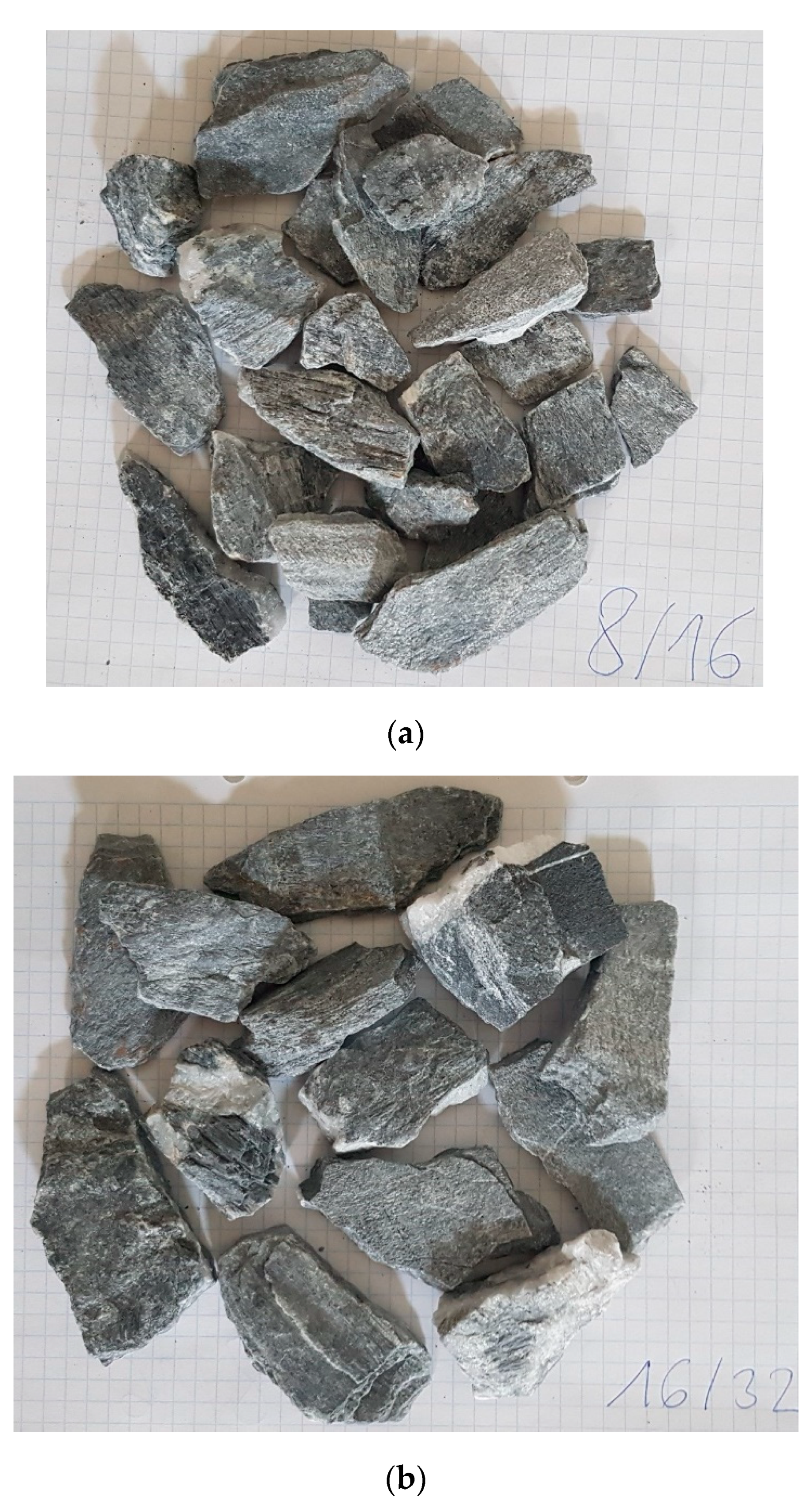
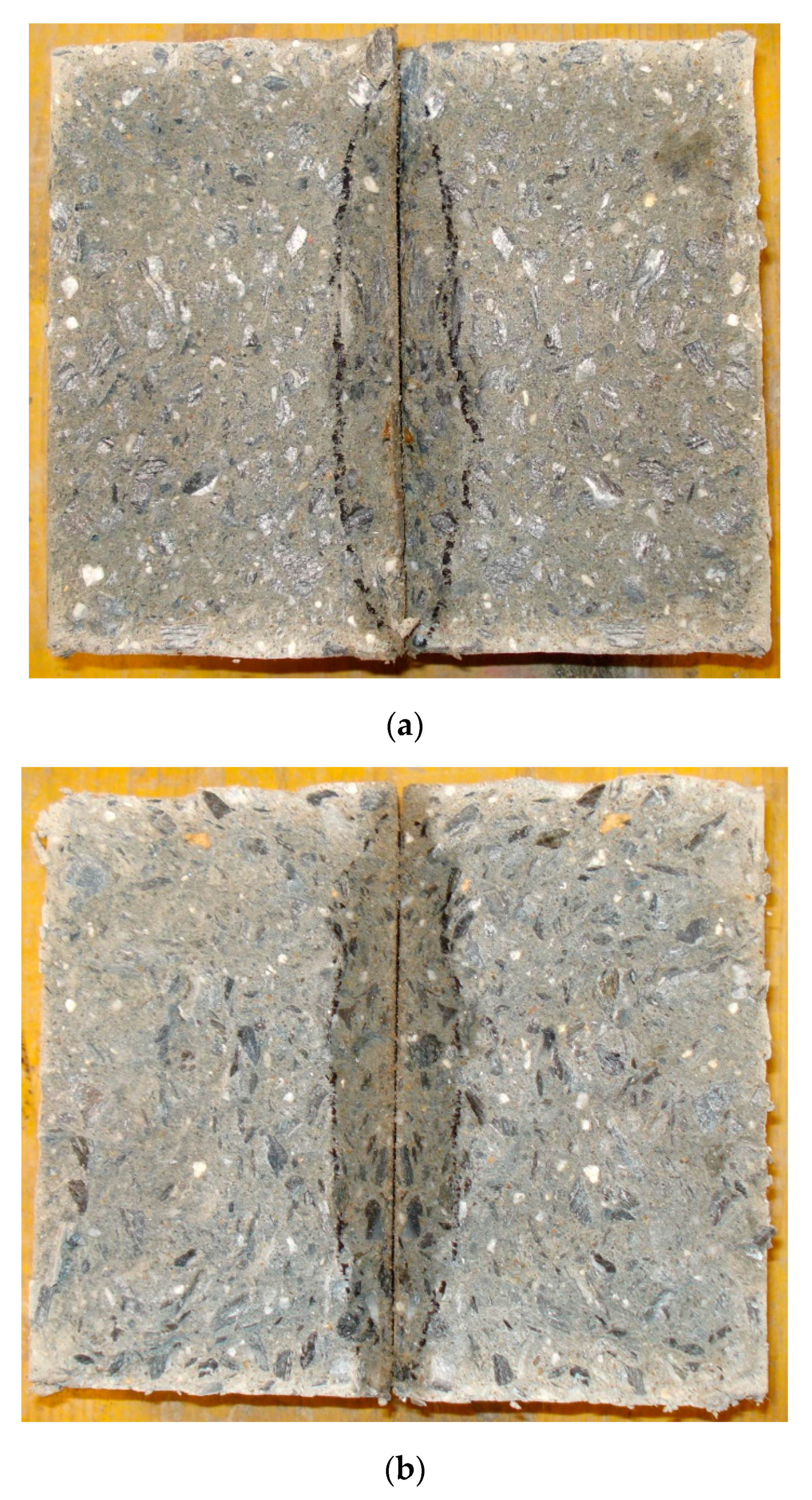
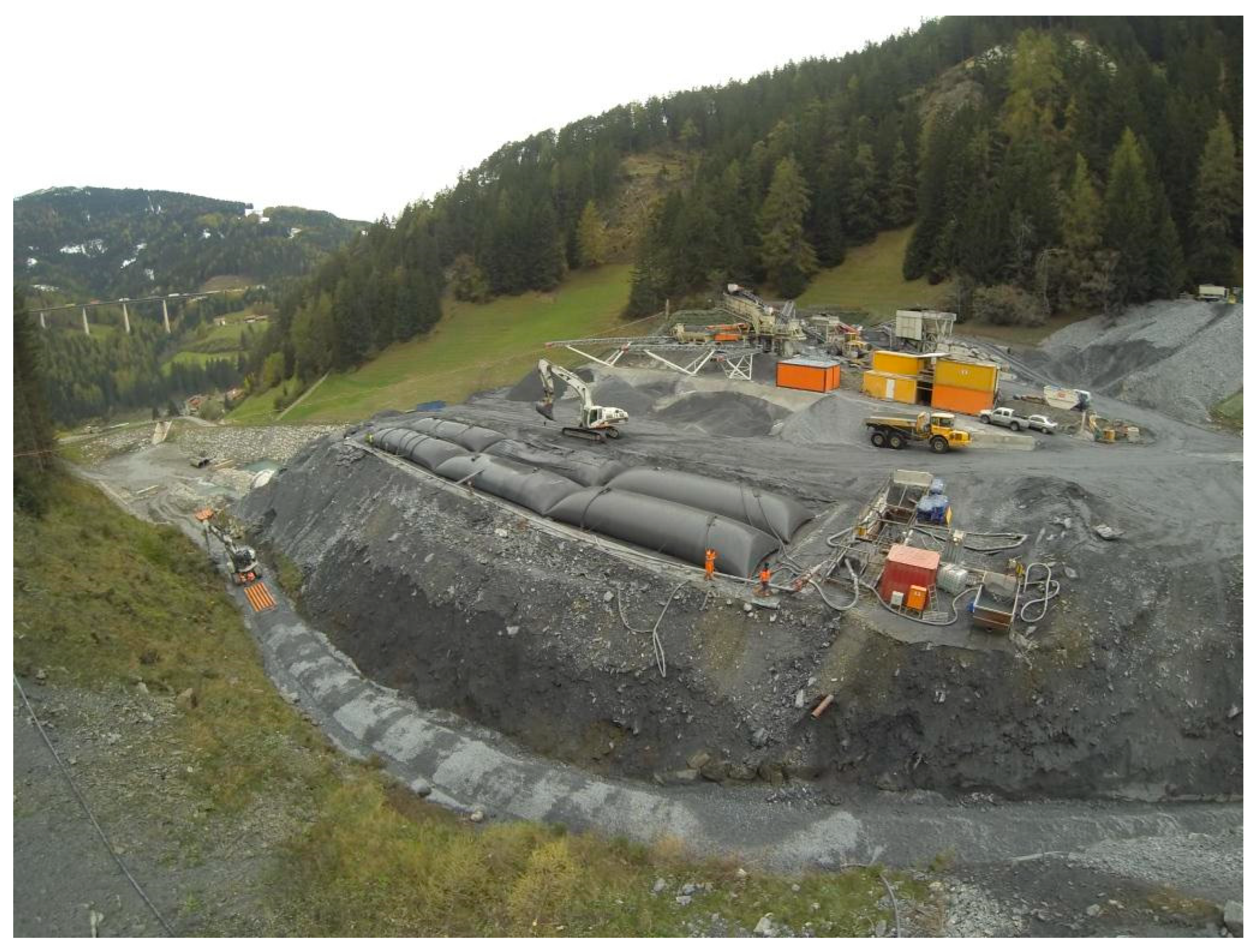
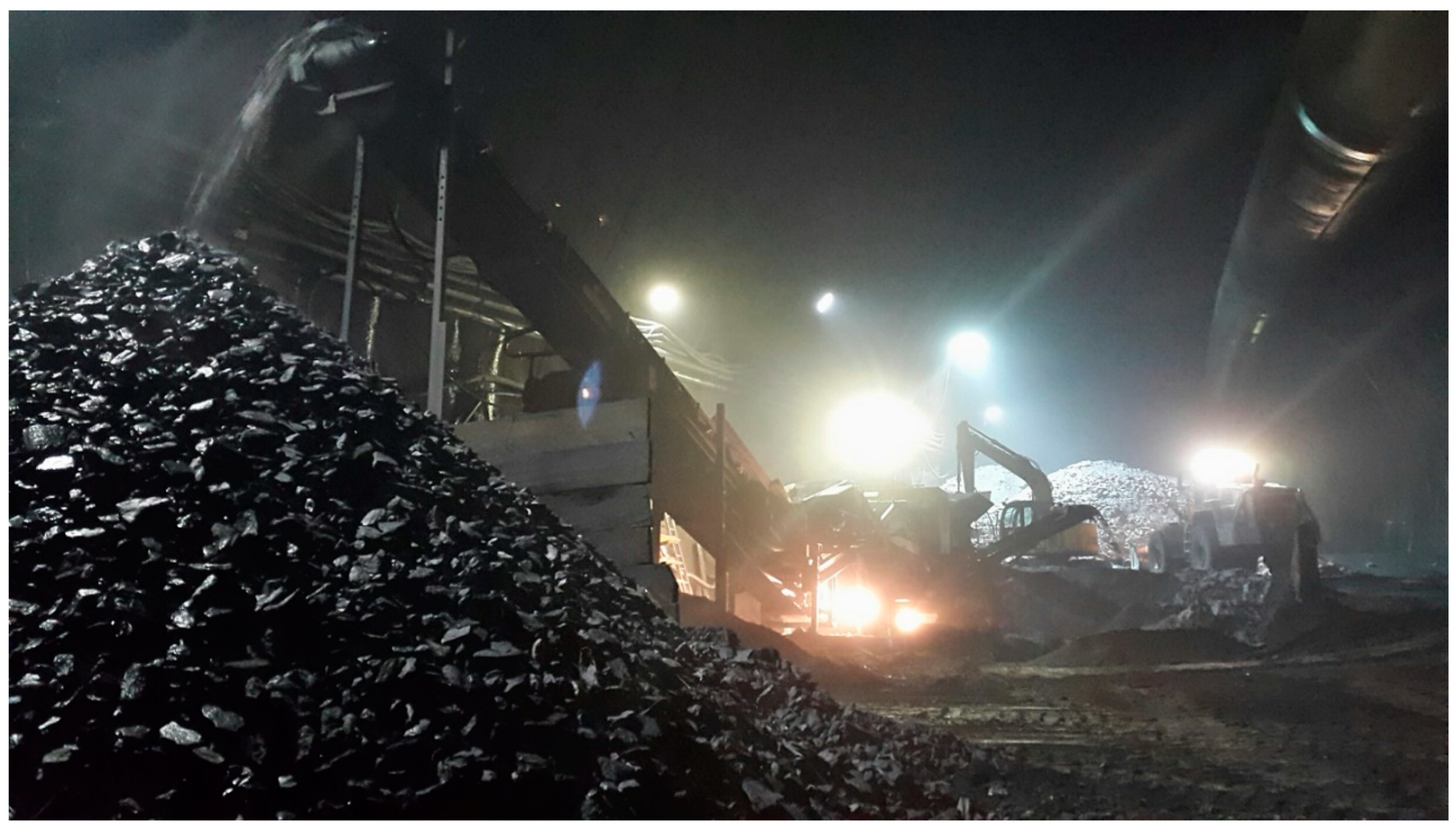
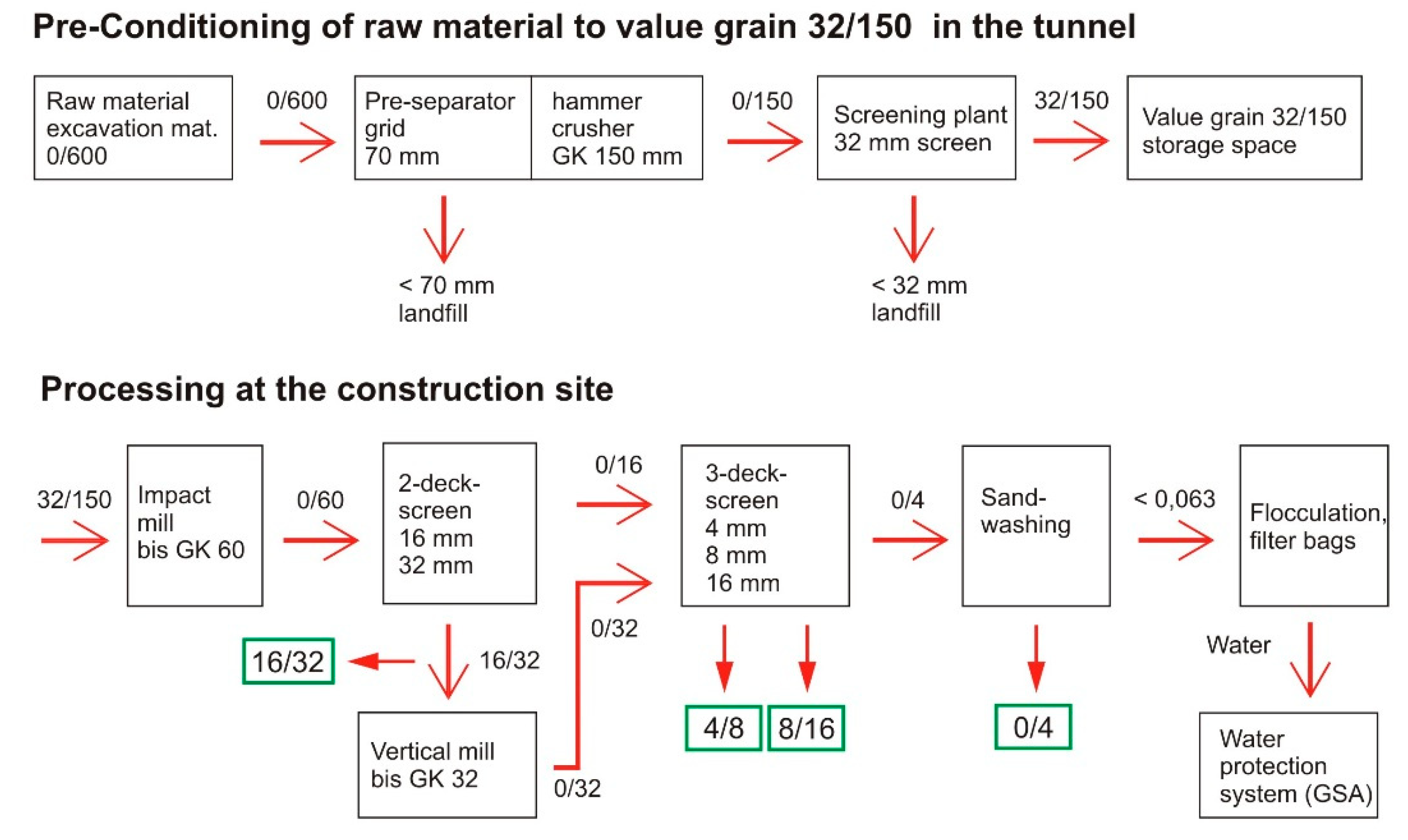
| Rock Properties | Quartz Phyllite Arithm. Mean * | Bündner Schist Arithm. Mean * | Evaluation |
|---|---|---|---|
| Bulk density [g/cm³] | 2.7 | 2.7 | required > 2.3 |
| Water absorption [%] | 0.4 | 1.7 | low and rather high |
| Unconfined compressive strength [N/mm²] | 45.0 | 76.0 | required > 50 MPa |
| Los Angeles value | 25.9 | 31.7 | LA30, LA35 |
| E-Modulus [GPa] | 24.8 | 38.2 | - |
| Tensile strength [N/mm²] | 4.8 | 8.5 | - |
| Point load index Is [N/mm²] | 4.0 | 5.8 | - |
| Schmidt hammer [N/mm²] | 45.0 | 52.6 | - |
| Freeze/thaw resistance [%] (EN 1367-1) | 0.4 | 0.5 | F1 |
| CAI Cerchar | 4.2 | 1.3 | very abrasive and abrasive |
| LCPC LAK [g/t] | 326.6 | 593.3 | abrasive and very abrasive |
| LCPC LBR (%) | 54.9 | 52.3 | highly crushable |
| Equiv. quartz amount [%] | 56.8 | 43.8 | - |
| Amount of mica and chlorite [%] | 28.0 | 29.8 | - |
| Acid-soluble sulfate [%] | - | 0.58 | required < 0.8% |
| Water-soluble chloride [%] | - | 0.0042 | required < 0.01% |
| Aggregate Characterization | Blasting | Tunnel Boring Machine | ||||
|---|---|---|---|---|---|---|
| Particle size group (mm) | 4/8 | 8/16 | 16/32 | 4/8 | 8/16 | 16/32 |
| Shape Index [%] | 68 | 81 | 84 | 66 | 73 | 74 |
| Concrete Components | kg/m³ | Specification |
|---|---|---|
| Cement | 260 | CEM II/A-M (S-L) 42.5 N |
| Hydraulically effective additives | 60 | Fly ash, slag sand |
| Water | 169.4 | Water/Binder ratio = 0.55 |
| Aggregate for concrete | 1937 | 0/4 mm quartz aggregate, 4–20 mm aggregate from Bündner Schist and Quartz Phyllite in each case |
| Additives: Plasticizer | 3.8 | BASF ACE GleniumSky |
| Mix | Consistency Fresh Concrete [mm] | Compressive Strength fc [N/mm²] | Bending Tensile Strength fct [N/mm²] | Specific Fracture Energy GF [N/m] |
|---|---|---|---|---|
| Bündner Schist aggregate | 605 | 47.7 | 3.6 | 167.7 |
| Quartz Phyllite aggregate | 590 | 42.5 | 3.4 | 238.4 |
| Particle Size Class | Flakiness Index FI [%] a) | Category of Fines a) |
|---|---|---|
| 4/8 mm | 7 | f1,5 |
| 8/16 mm | 12 | f1,5 |
| 16/32 mm | 17 | f1,5 |
© 2020 by the authors. Licensee MDPI, Basel, Switzerland. This article is an open access article distributed under the terms and conditions of the Creative Commons Attribution (CC BY) license (http://creativecommons.org/licenses/by/4.0/).
Share and Cite
Voit, K.; Kuschel, E. Rock Material Recycling in Tunnel Engineering. Appl. Sci. 2020, 10, 2722. https://doi.org/10.3390/app10082722
Voit K, Kuschel E. Rock Material Recycling in Tunnel Engineering. Applied Sciences. 2020; 10(8):2722. https://doi.org/10.3390/app10082722
Chicago/Turabian StyleVoit, Klaus, and Erik Kuschel. 2020. "Rock Material Recycling in Tunnel Engineering" Applied Sciences 10, no. 8: 2722. https://doi.org/10.3390/app10082722
APA StyleVoit, K., & Kuschel, E. (2020). Rock Material Recycling in Tunnel Engineering. Applied Sciences, 10(8), 2722. https://doi.org/10.3390/app10082722





